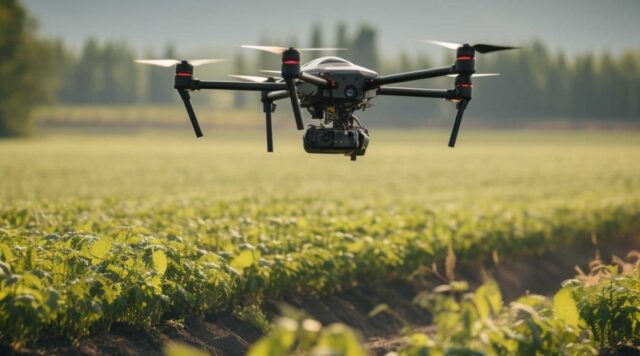Drones in Agriculture: Revolutionizing Farming Practices
Drones, generally called unmanned aerial vehicles (UAVs), have in no time gained fame across various regions, including agriculture. These flying machines, initially created for military applications, have tracked down their way into the quiet and useful fields of farming. Drones in agriculture are a unique advantage, offering a great many applications that further develop production, decrease expenses, and improve the general efficiency of the farming area.
Key Applications of Drones in Agriculture
- Crop Monitoring and Assessment
One of the central purposes of drones in agriculture is crop monitoring and analyzing. Standard techniques for assessing crop wellbeing and progression can be repetitive and work intensive. Farmers waste majority of their time upon visual inspections, which can miss indications of crop disease. Drones armed with huge standard cameras and multispectral sensors can get synchronized pictures of crops from a higher spot. This information can then be examined to see issues like improvement needs, bug infestations, and disease, allowing for ideal intervention.
- Precision Agriculture
Drones empower accuracy agriculture by providing ranchers with significant information on their fields. By flying over the farmland, drones can gather information on soil quality, dampness levels, and temperature varieties. This information assists ranchers with making informed choices about when and where to plant, flood, or apply composts and pesticides, optimizing asset utilization and maximizing crop yields
- Irrigation Management
Compelling water system is basic for fruitful farming. Drones furnished with thermal imaging cameras can distinguish varieties in soil dampness and temperature, identifying regions that might require pretty much water system. This considers exact and productive water appropriation, reducing waste and saving on water costs.
- Pest and Disease Control
Nuisances and infections can unleash ruin on crops, causing critical financial misfortunes for ranchers. Drones can be utilized for early recognition and control of these dangers. By flying over fields, drones can recognize indications of infestations or illnesses, enabling convenient treatment with minimal harm to the crops. This proactive methodology can set aside both cash and assets.
- Crop Spraying
Customarily, crop spraying has been performed using work vehicles or handheld gear. Drones outfitted with specific spraying frameworks can now productively and exactly apply pesticides or composts to crops. This strategy decreases the hazard of over-application and minimizes openness of farmworkers to synthetics. In addition, it considers admittance to hard-to-reach or lopsided terrain, which can be a test with traditional machinery.
- Livestock Monitoring
Drones can likewise be utilized in animals farming to screen the wellbeing and condition of animals. They can give aerial perspectives on the crowd, check for strays, and even distinguish wiped out or injured creatures. This innovation permits ranchers to respond quickly and give better consideration to their animals
Benefits of Drones in Agriculture
The integration of drones in agriculture offers various advantages to farmers and the industry all in all:
- Increased Productivity: Drones fundamentally diminish the time and application expected for monitoring and assessing crops, which means increased proficiency in farming tasks.
- Cost Decrease: By optimizing asset use, like water, manures, and pesticides, ranchers can save money on costs. Moreover, drones can assist with preventing crop misfortunes because of sickness or bugs, further reducing costs.
- Upgraded Yield: Precision agriculture, made possible by drone data, can boost crop yields by ensuring that crops receive the right resources at the right time.
Accuracy agriculture, made conceivable by drone information, can support crop yields by ensuring that crops get the ideal assets with flawless timing. - Sustainability: Drones advance sustainable farming by minimizing the natural effect of agriculture through proficient asset use and diminished substance applications.
- Safety: Drones eliminate the requirement for physical work in possibly dangerous circumstances, for example, inspecting tall or lopsided terrain, which further develops security for farmworkers.
- Timely Navigation: Constant information given by drones engages ranchers to pursue speedy and informed choices, which is basic in agriculture
Challenges and Considerations
While the utilization of drones in agriculture presents various benefits, there are additionally a few moves and contemplations to consider:
- Initial Investment: The expense of purchasing and maintaining drone hardware can be a huge boundary for limited scope ranchers.
- Regulation: The utilization of drones in this dependent upon guidelines and limitations that shift starting with one locale then onto the next. Ranchers need to explore these guidelines and obtain important grants.
- Data Administration: The tremendous measure of information gathered by drones requires appropriate capacity, investigation, and interpretation. Ranchers might have to invest in information the board arrangements or administrations.
- Training: Farmers and rural laborers should be trained to operate drones and interpret the information gathered.
- Privacy Worries: Drones can inadvertently take pictures of neighboring properties or individuals, raising worries about security.
Future Trends and Developments
The reception of drones in agriculture is still in its beginning phases, and the innovation is continuously evolving. A few patterns and improvements are shaping the eventual fate of drones in agriculture:
- Autonomous Drones: Progressions in AI and machine learning are leading to the advancement of independent drones that can work without consistent human intervention.
- Increased Payload Limit: Drones are becoming fit for carrying heavier payloads, allowing for additional different applications, for example, transporting harvested crops or delivering little gear.
- Integration with Different Innovations: Drones are increasingly being integrated with other farming advances, for example, GPS-directed work vehicles and mechanized harvesting gear.
- Improved Sensors: Ongoing enhancements in sensor innovation are enhancing the accuracy and nature of information gathered by drones.
Conclusion
Drones in agriculture are revolutionizing farming practices by offering innovative answers for age-old issues. The various utilizations of drones in agriculture, from crop monitoring to bother control, are improving effectiveness, reducing costs, and increasing efficiency. The advantages of integrating drones into farming activities are clear, yet there are likewise provokes that should be tended to, like guidelines and information the board.
The eventual fate of drones in agriculture holds extraordinary commitment. As innovation continues to propel, drones will turn out to be considerably more refined and integrated with other horticultural advancements. This will enable ranchers to settle on additional informed choices, increase crop yields, and add to sustainable and proficient farming practices.








